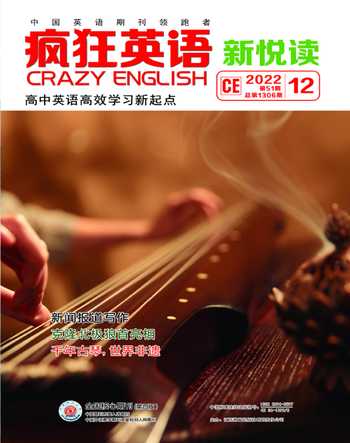千年古琴,世界非遗
2022-12-19江丽
江丽
古琴是中华民族最早的弹拨乐器,是中华文化中的瑰宝。它以其历史久远、文献浩瀚、内涵丰富和影响深远为世人所珍视。
1 Guqin, a seven?stringed plucked (弹拨) instrument, is Chinas ancient and most representative musical instrument. According to early archaeological (考古学的) discoveries, guqin originated from the prehistoric period and fully developed during the Han Dynasty.
2 Guqin was viewed as a symbol of high culture in China. In ancient China, guqin, the game of go, calligraphy and painting were the four arts scholars should master, with guqin coming in first. Guqin was always an art form not intended for public performance as the point of playing the instrument was to enjoy music, develop ones taste and bond with friends. There is a well?known story about the friendship between famous guqin player Yu Boya and his biggest fan Zhong Ziqi, both of whom grew to understand each other through music. Although the pair lived more than 2,000 years ago, even today Chinese people still refer to their story to describe friendship.
3 Guqin has seven strings and 13 marked pitch (音高) positions. By attaching the strings in 10 different ways, players can produce a range of four octaves (八度音階). The three basic playing techniques are known as san (open string), fan (harmonics) and an (stopped string). According to tradition, it takes 20 years of training to become proficient in the instrument. The sound of guqin is deep, remote and light. More than 100 harmonics have been preserved using a unique notation system, and most of the tunes have been passed down orally from teachers to students.
4 Guqin techniques are divided into various schools around the country, including Yushan, Guangling, Zhejiang, Zhucheng and Lingnan schools among others. The most famous musical works include White Snow in Sunny Spring, Three Stanzas of Plum Blossoms, High Mountain and Flowing Waters and so on.
5 Due to the influence of Western music and modern media, guqin music was in danger of becoming lost. In order to protect it, the instrument was listed as a national intangible cultural heritage in China in 2006 and was listed on the Representative List of the Intangible Cultural Heritage of Humanity by UNESCO in 2008.
1. Why did people in ancient China learn guqin?
A. To perform in public.
B. To produce famous musical works.
C. To enjoy music, develop ones taste and make friends.
D. To kill their boring time.
2. Whats the purpose of mentioning Yu Boya and Zhong Ziqi?
A. To show their talents.
B. To show the influences of guqin.
C. To show their popularity in history.
D. To show the true friendship between them.
3. How were most of guqin tunes passed down from teachers to students?
A. By spoken words.
B. By writing them down.
C. By digital records.
D. By singing special songs.
4. What does the last paragraph talk about?
A. Famous guqin works.
B. Guqin techniques.
C. Influences of Western music.
D. Measures to protect guqin.
Useful expressions
originate from 起源于
be viewed as a symbol of 被看作是……的象征
intend for 为……而准备
bond with 与……交往
understand each other through music 通过音乐了解彼此
refer to 提及
become proficient in 变得精通……
古琴的三种音
古琴的音色分三种——散音、泛音、按音。散音松沉而旷远,让人起远古之思;泛音则如天籁,有一种清冷之感;按音则非常丰富,细微悠长,时如人语,似在对话,时如人心之绪,缥缈多变。泛音像天,按音如人,散音则同大地,称为天地人三籁。因此,古琴一器具三籁。
